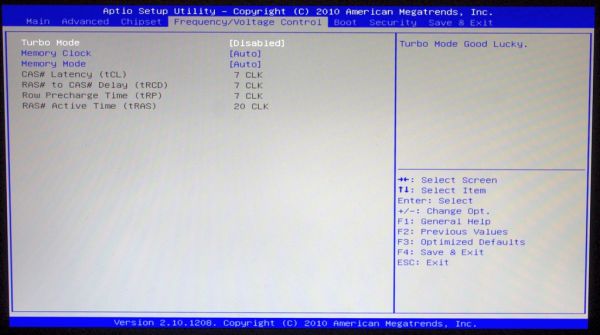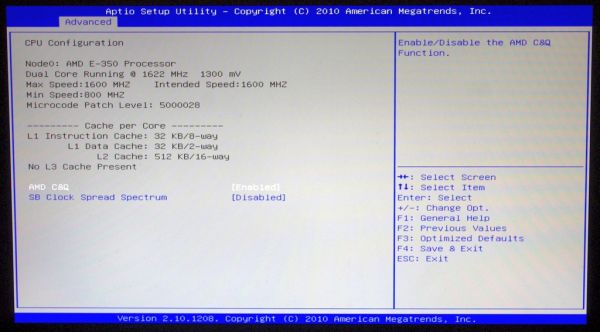Fusion E-350 Review: ASUS E35M1-I Deluxe, ECS HDC-I and Zotac FUSION350-A-E
by Ian Cutress on July 14, 2011 11:00 AM ESTECS BIOS' of past have been rather lacking, in terms of options and design. Sadly, the HDC-I is no exception to this rather flat rule. The take on it seems to be 'it works, so much for the user experience'. Options are, for the most part, spread out across menus rather than being consolidated, and there's no serious information connection. Take the main page - there's no mention of the motherboard type, the CPU model currently in it, the speed of the processor, the amount of memory or the temperature. This information is on other screens, but it's nice to have it on the first screen at least.
By default the SATA ports are set to IDE rather than AHCI, but the money shot of the BIOS is in the 'Frequency/Voltage Control' Menu. The first option here is the 'Turbo Mode', with the help message of 'Turbo Mode Good Lucky'.
What this option does is impressive. Change it to the enabled setting, and the board will apply a 33% overclock to the processor, and automatically adjust the voltage. With this option as standard, they've decided against adding any other overclock options (like the ASUS board) apart from the memory, where DDR3-800 to DDR3-1333 are selectable (which equates to DDR3-1064 to DDR3-1777 when overclocked), as well as the major subtimings. By default, DDR3-800 and 7-7-7-18 were selected when left on auto on our Patriot Viper Xtreme set.
The other positive feature of the BIOS is the boot override - something every BIOS should have by now. If you want a one-time boot from a separate device (CD, DVD, USB) then this is the option to do it. It thankfully accepts NTFS file systems (unlike some ASRock boards) as well.
Overclocking
In terms of overclocking, there's not much to say, apart from the turbo mode available in the BIOS, adding 33% clock speed to 2.13 GHz. The default bus speed flickers between 100 MHz and 102.1 MHz, so at overclock it flickers between 133 MHz and 135.1 MHz, giving a little advantage over other boards. This 33% boost also affects the memory, turning the DDR3-1333 setting into DDR3-1772, which is also a large improvement. There are no overclocking options for the OS though.
The overclock gave a boost of 34.5% boost to our single threaded 3D Movement benchmark, and a 33.0% boost to the multithreaded version. In terms of power, during video, the overclocked version consumed 5W more as a peak value, though this difference was not seen in Metro2033 or OCCT.



















67 Comments
View All Comments
Anato - Saturday, July 16, 2011 - link
I'm worried about Anandtechs reputation and objectivity of AMD reviews. As a reader I can say from the text when the article is about AMD even if I hide all the product names and technical words. The wording is different and the questions put up are doubtful. Also focus is put to things where product is not intended to.Then there is benchmarks where always there is this "magical" Intel on top of the chars, but no word about the setup (mb, cpu, memory) costing 3 times more. Words from Atom review: "When the Atom first appeared I immediately did my best to characterize its performance."
Next big thing is that there is no Atom on the chars, why? No wonder Core i5 2500K beats up the E-350, but why is it not put to power chars?
PSU, if you don't have the gear to test then don't publish misleading results instead. Never have seen this happen on Intel, like "We only had one DDR3 Dimm"
Last two points go to GF 580? Who would put this to Atom/E-350 board? And again no Atom around "holding GPU back".
I really appreciate what you are doing in SSD-front and many other areas but for me this review isn't right.
duploxxx - Thursday, July 14, 2011 - link
Official Hudson D3 TDP = 7.8W, doesn't mean it actually draws that much power.so pls change power draw to TDP....
Spivonious - Thursday, July 14, 2011 - link
The first one looks like it has great potential for an HTPC build. Stick it in an ITX case with a fan to exhaust the hot air and you have a quiet, powerful, and small HTPC.SanLouBlues - Thursday, July 14, 2011 - link
The DirectX 11 patch for Crysis 2 is out now.Vepsa - Thursday, July 14, 2011 - link
I'm considering a Hudson board for my home server (probably the ECS one to be honest) and I'm wondering if the SATA/eSATA ports support port multiplier technology. If they do, the would be just about perfect for me.yeeeeman - Thursday, July 14, 2011 - link
Until I have seen two or three reviews on the Internet who don't try to give a wrong impression about the power consumption of an AMD system based on E-350.Even myself, and I'm not a pro in this domain I have a 200W power supply who gets much better results than the you've used.ckryan - Thursday, July 14, 2011 - link
I love the ITX form factor. I love it's limitations. I love the necessity of axing the dead weight -- no PATA, no PCI, ect. Graphical UEFIs are great, and I'm ready to do away with the trusty old BIOS. So there isn't much to get in the way of, even if the E-350 isn't the hottest of the new hotness. Thanks, Ian, for an excellent round up. It's easy for motherboard reviews to get lost in the shuffle, and this roundup is worth the read.onlineaddy - Thursday, July 14, 2011 - link
So, what's the author's conclusion/recommendation? Is any one of the three worth our hard-earned $?Rick83 - Thursday, July 14, 2011 - link
First of all: 100Mb LAN test was a waste of time/space, especially the graphic.A Gbit LAN test on the other hand might have been interesting, as these small computers can be used as thin clients, relying heavily on low latency and high troughput.
Also, the processor time graphic should have been for Gbit LAN, as pushing 8MB/s over a line is not nearly as taxing as doing the same for 80 MB/s (buffering a movie off remote storage, loading a user profile during log-in, etc)
The performance graphs seemed to me to be an excercise of futilty, dedicated to measuring noise. Three identical chipsets and three identical cpus would not diverge beyond noise in the clock generator.
The conclusion is also way too performance oriented.
The Zotac isn't bad because its performance is middling or because it lacks overclocking. As a passive design, overclocking can be safely ignored anyway, and a socket 1156 board can be gotten in miniITX size that will blow this out of the water, at a similar cost.
What is wrong with the Zotac, is that there are plenty of issues, that have arisen during testing.
Not as bad as an unstable UEFI image, but the lower than average usb-performance, the latency spikes - those can be really annoying.
And, frankly, the ECS, including VGA? That's a bit archaic...
I think performance for platforms that are not performance oriented is not really the most important point, even if that's what you're used to.
In general, for mainboards performance isn't the most important factor. Build quality, stability, software and features are far more important, as is the quality of the onboard non-PCH hardware, like sound quality, WLAN performance, LAN performance, quality of the VGA outputs, memory compatibility and many other things that sadly don't get covered in main board reviews.
I'd be glad if more relevant (perhaps only to me) factors for purchase decisions were to feature in future reviews.
And please test that ASUS Gene-Z soon, pretty please?
IanCutress - Thursday, July 14, 2011 - link
Hi Rick,I'm always open to comments or alternative tests that could be run - updating the test suite is always in motion as and when what is required. Bare in mind that as we're individual reviewers at AT, we don't all have access to the appropriate gear for testing right away. If you've got any suggestions, you can email me from my name at the top of the review.
All the best,
Ian